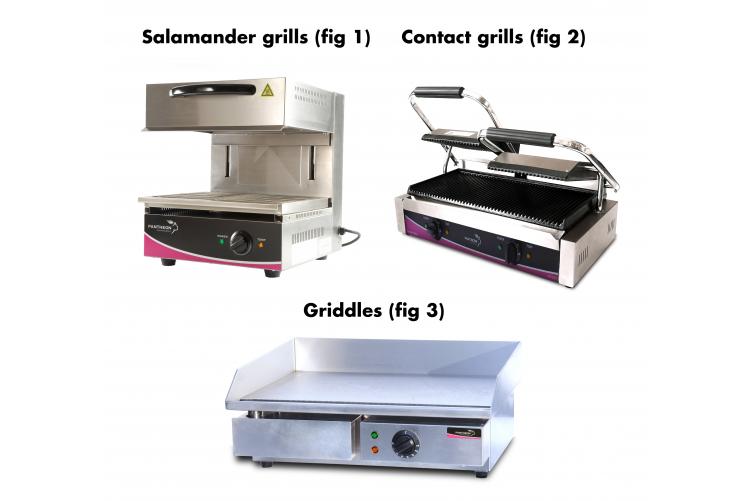Grills and griddles have a unique feature among kitchen equipment: they are the only items of prime cooking equipment that require nothing else before cooking begins. Even a fryer needs a basket. While sometimes thought of by chefs as a one-dimensional form of cooking, there is far more versatility to be had from a grill or a griddle than appears at first glance. These are the options:
Salamander grills: Pantheon AS450 (fig1)
Salamander grills cook using heat radiated downwards on to food from either gas or electric radiants. There are two designs to choose from. The most popular is with the grill tray kept in a fixed position and the radiant head assembly pulled down to control the level of heat applied to the food. These are called rise and fall grills.The other method sees overhead radiants in a fixed position and cooking controlled by a combination of heat setting and position of the grill tray.
Contact grills: Pantheon CGS2R Contact Grill (fig2)
A contact grill achieves its results by cooking food between two heated surfaces.
This has many benefits over the conventional griddle: it cooks much more quickly, seals the food more effectively and locks in more of the juices, improving the flavour and reducing shrinkage. Because the food is being cooked simultaneously on both sides, cook times can be as short as three minutes for steaks, chops and chicken fillets.The top and bottom grilling plates are connected by a floating hinge which, by swivelling upwards as well as outwards, allows food of varying thickness to stay in contact with both grill plates. Contact grills can come as single grills or side-by-side double grills, each operating independently. There can be a locking facility on the hinge so the top plate is close to the food but not pressing on to it, a feature useful for contact-grilling fish. Power supply is usually 13amp single-phase, so professional rewiring is not required.It is good practice to continually wipe the grill plates to remove food debris, which will become baked on and harder to remove if left. A wipe-down is also needed between fish and meat, and meat and vegetarian items, such as vegetable brochettes, which cook well on a contact grill.Griddles: Pantheon G1 Griddle (fig3)
Griddles are popular for breakfast preparation in small catering operations and for burger cooking. Eggs can be a challenge for griddle cooking because of the risk of sticking and the need for basting to finish the top of the egg. A way round this is to use greased metal cutters placed on the griddle surface into which the raw egg is dropped. This builds up the bulk of the egg, and the heat from the sides of the metal cutter helps in cooking it. A flip of the egg using a soft metal scraper will firm and darken the surface unless a "sunny side up" finish is required.
Pantheon Griddles are powered by electricity. Those with a larger grilling area may have a dual-heat facility with just one half of the grill taking power for low-demand times of the day. The whole griddling area will remain very warm, so cooked food can be held on it without direct heat.
The griddle surface is made of steel and is available in four forms: cast iron and carbon steel are cheaper, but need careful cleaning and oiling to prevent corrosion; stainless steel is more expensive, but easier to keep clean; chrome-coated griddles, sometimes called mirror griddles, tend to be less prone to food sticking and are easier to keep clean, but need far greater care during cooking and cleaning. While cast iron and steel griddle surfaces will withstand rough use with a spatula or scraper, a chrome griddle will get a scored surface, which will hinder its non-stick property and risk corrosion. Heat-resistant plastic spatulas that will not damage the surface of a chrome griddle are available. Cleaning of chrome griddles should be with a cloth, not abrasive scrubbers, which will damage the surface.Because griddles need constant scraping while food is being cooked to clear away fat and food debris, there should be a grease channel around the rim of the griddle plate or a metal wall to prevent debris from falling onto the floor. There should be a chute in one corner, down which food debris and fat can be pushed into a collection box. Cleaning down at the end of shift is messy, but is essential for food safety and hygiene.

